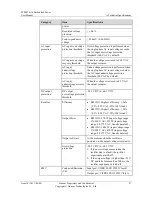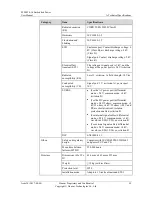
ETP4830-A1 Embedded Power
User Manual
7 Maintenance
Issue 10 (2017-08-08)
Huawei Proprietary and Confidential
Copyright © Huawei Technologies Co., Ltd.
47
3.
Check whether the battery temperature sensor is faulty. If yes, replace the temperature
sensor.
7.2.9 Batt Under Temp
This alarm is generated only for the power system that has battery temperature sensor installed.
Possible Causes
The battery undertemperature alarm threshold is not set properly on the SMU.
The battery temperature controlling system is faulty.
The battery temperature sensor is faulty.
Measures
1.
Check whether the battery undertemperature alarm threshold (0°C by default) is properly
set. If no, adjust it to a proper value.
2.
Check whether the battery temperature controlling system is faulty. If yes, rectify the
fault. The alarm is cleared when the battery temperature falls within the allowed range.
3.
Check whether the battery temperature sensor is faulty. If yes, replace the temperature
sensor.
7.2.10 Batt Chg. Overcur.
Possible Causes
Rectifier communication is interrupted.
SMU connections are loose.
The SMU is faulty.
Measures
1.
Check whether an alarm has been generated for interrupted rectifier communication. If
so, remove the rectifier, reinstall it, and check whether the alarm is cleared. If the alarm
still exists, replace the rectifier.
2.
Remove the SMU, reinstall it, and check whether the alarm is cleared. If the alarm still
exists, replace the SMU.
7.2.11 Load Loop Break
Possible Causes
The load circuit breaker has tripped or the load fuse has blown.
The load circuit breaker or the fuse detection cable is disconnected.
Measures
1.
Check whether the load circuit breaker has tripped or the load fuse has blown. If so,
locate and rectify the circuit fault, and then switch on the circuit breaker or replace the
fuse.




























